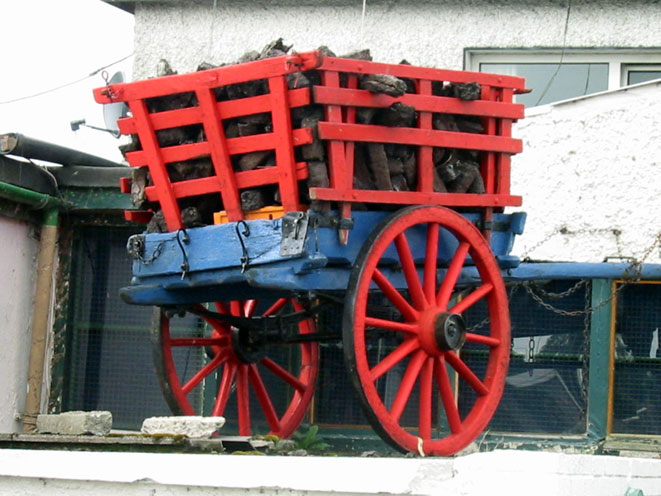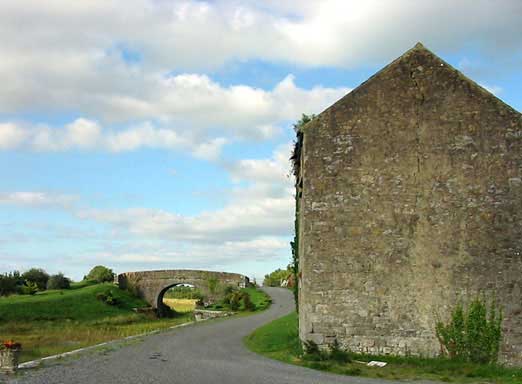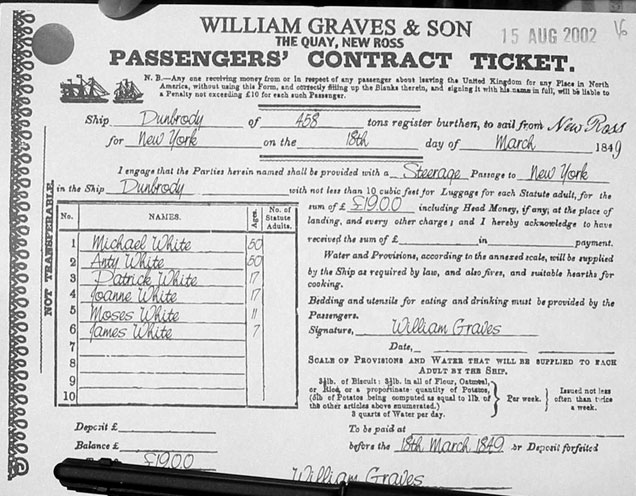| The
two biggest ones were ran by Frederick Sabel (Union Hotel)
and Frederick Marshall, at 28 Moorfield and at Clarence
Dock, respectively. In the 1850s, Sabel’s charged one
shilling a day for bed and three meals. Marshall’s charged
four pence a night. Most emigrant boarding houses were
of the filthiest kind. Emigrants sometimes even had to
bed down in cellars that were as destitute of comfort
and convenience as they were overcrowded, with the landlord
making a profit on each warm body.

Carts like this one were used by emigrants to transport
their baggage on short distances. |
From
1851 onwards, before the day of departure, emigrants had
to go through a medical inspection by government doctors.
The examination was undertaken by government decree to
prevent any outbreak of contagious disease on board. However,
doctors worked at factory speeds, going automatically
through the ritual of examining as many tongues and feeling
as many pulses as it was possible to do and still keep
within the letter of the law. On Monday, which was the
busiest day, sometimes more than 1,000 emigrants were
waiting outside the office (known as the Doctor’s Shop),
in which there were two inspectors. Lodging-house keeper
Sabel called this inspection a farce: doctors ‘start behind
a little window, and when the people come before them
they say: “Are you quite well? Show your tongue,” and
in the mean time their ticket is stamped’ [Préteseille
1999]. The stamp proved that the emigrant had been inspected
and sometimes as many as 2,000 or 3,000 people were inspected
in a day.
Most
emigration vessels departed from the Waterloo dock, and
‘passengers where entitled to board the ship twenty-four
hours before departure’ [Préteseille 1999]. However, since
most of the emigrants bound to South America boarded cargo
ships, their captains often did not allow the passengers
to board until the last minute, when the cargo had finally
been stowed in the hold. In fact, the captain often started
to move his vessel before emigrants had time to get on
board. When the captain was doing so or when the passengers
arrived too late (which was quite common), that is to
say after the gangplank was raised, then they went to
the dock-gate.

The Royal Canal: store-house in Ballybranningan
Harbor, Ballymahon, Co. Longford (2002) |
The
entrance of the dock was narrow and ships were detained
there for a short time while other vessels were going
out. During that time,
Men,
women and children were scrambling up the sides of the
ship. One could see hundreds of people confused, screaming.
Luggage and boxes were flung aboard, followed by the passengers.
When they or their luggage missed the ship and fell into
the water there was usually a man in a rowing boat ready
to rescue and get his reward. But sadly there was not
always someone there to rescue and consequently a few
people drowned. Those who did not manage to get onboard
at the dock-gate had no choice but to hire a rowing boat
to catch up the ship down the river Mersey. The boatmen
would not do it for less than half a sovereign (10 shillings).
Getting on board a ship was really rough, even for the
cabin passengers [Préteseille 1999].
There
were usually a large number of spectators at the dock-gates
to witness the final departure of the ship. The sad scene
of the departure was described in the Illustrated London
News in 1850: ‘The most callous and indifferent can
scarcely fail, at such a moment, to form cordial wishes
for the pleasant voyage and safe arrival of the emigrants,
and for their future prosperity in their new home. As
the ship is towed out, hats are raised, handkerchiefs
are waved, and a loud and long-continued shout of farewell
is raised from the shore, and cordially responded to from
the ship. It is then, if at any time, that the eyes of
the emigrants begin to moisten’ [in: Préteseille 1999].
Trans-Atlantic
Crossing
Once
the emigrants managed to get on board the ships, the following
stage in the emigration process was to cross the Atlantic
ocean. The Irish emigrants who departed from Liverpool,
sailed back the way they had come, towards Ireland, with
the winds dictating their routes: north around Mallin
Head, or south by the Waterfront Estuary, Cove and Cape
Clear. The sea crossing was not an easy voyage. It was
long, taking between one and three months, and the sea
was a strange environment to most emigrants, especially
for those from rural areas in Longford and Westmeath.
[7]
Aboard
many ships bound to North America the risks were so great
that there were numerous deaths, and these ships became
known as ‘coffin ships’. There is no evidence that the
journey to South American ports like Rio de Janeiro, Montevideo,
or Buenos Aires, was as dangerous as that of the emigrant
ships bound to North America. In fact, due to insurance
requirements, the ships sailing from Liverpool to the
River Plate were mostly first and second-class, i.e.,
surveyed and judged as best or good quality in terms of
age, condition and seaworthiness, whilst many of the coffin
ships were third-class vessels, a status which prohibited
any but short voyages. In addition to this, most of the
vessels in the North American seaway were built in Canada
or the US, while those destined for the South American
trade were built in England by more experienced dockyard
workers. Ships sailing the South Atlantic routes often
had purposes other than the transport of emigrants, such
as: mail, cargo, and cabin passengers. Emigrants were
often piled into steerage. It wasn’t until the late 1880s
that the emigrant trade proper emerged in the South Atlantic,
when crowds of emigrants – especially from the Mediterranean
countries – began to escape from the poor conditions in
their home countries in order to find a new life in Buenos
Aires and other South American regions.

Facsimile of a trans-Atlantic ticket of the Dunbrody,
(Newross, Co. Wexford) |
We
can divide the nineteenth-century transatlantic transport
between the British Isles and this region into two periods
that correspond to advances in navigational technology:
sail (1824-1850) and steam (1851-1889).
The
sail period begins with the opening of the British mail
packet route to Buenos Aires, and the arrival at this
port of the first packet, Countess of Chichester.
The majority of ships were wooden sailing vessels. The
Countess of Chichester sailed from Falmouth, England,
and ‘reached Buenos Aires on 16th April [1824], having
called at Montevideo one or two days previously’ [Howat
1984: 42]. This was the result of the negotiations between
Woodbine Parish (1796-1882), the first appointed British
Consul-General to Buenos Aires, and Bernardino Rivadavia,
then Minister of State of the Argentine Provinces and
two years later President of the Republic for 18 months.
The agreement, a good example of British-Argentine diplomacy,
‘worked up into a set of regulations, [and] proved to
be so advantageous to Britain, that the English packets
had an effective monopoly for at least 25 years to carry
all overseas mails to Europe, apart from those taken by
trading ships’ [Howat 1984: 42]. |


